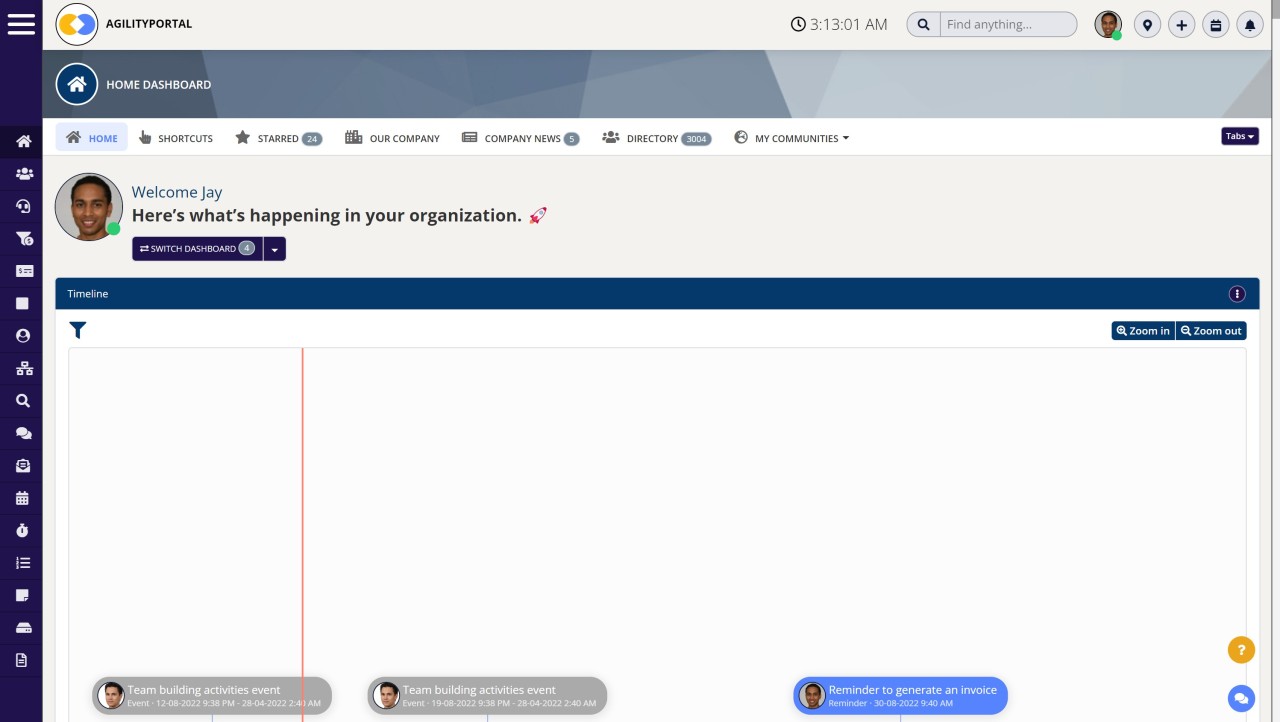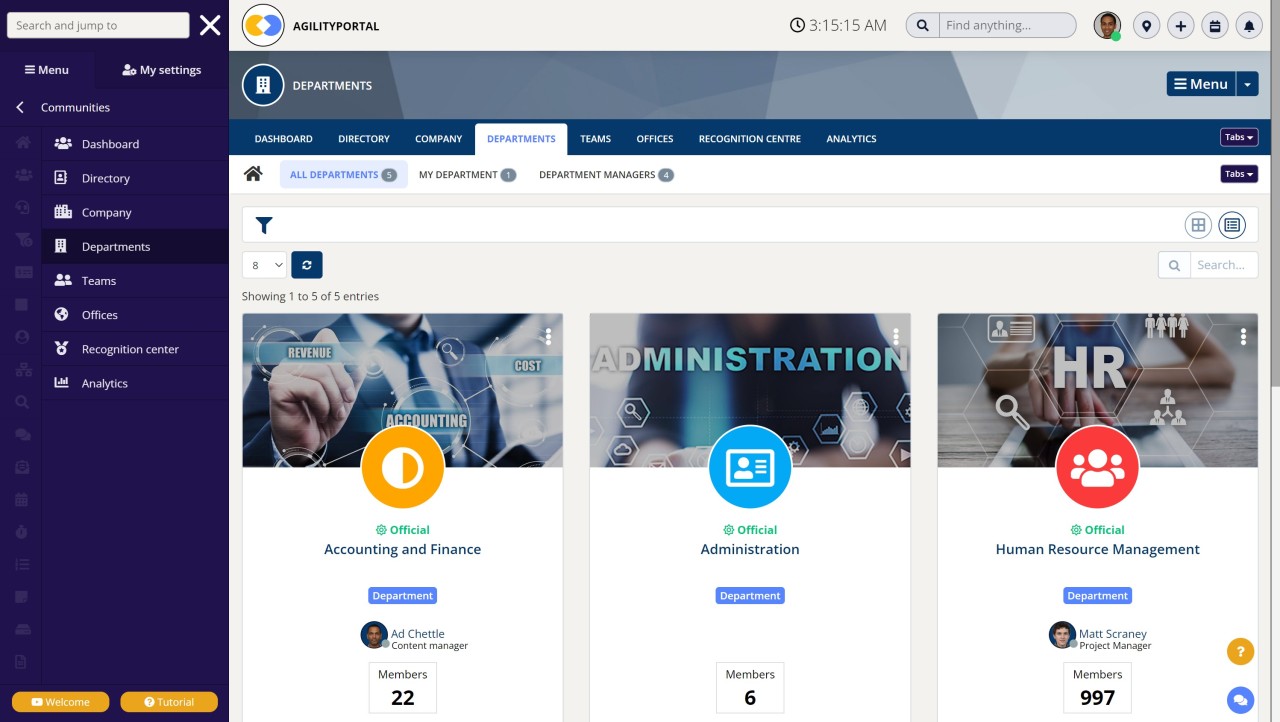Insight Blog
Agility’s perspectives on transforming the employee's experience throughout remote transformation using connected enterprise tools.
7 minutes reading time
(1407 words)
Reasons why you must have a social intranet for your business
A quality social intranet software can provide staff with access to all the information they need to rapidly and effectively help customers. Increase productivity.
The intranet is a network that uses social software to aggregate information within a business. When it comes to social media, team sites may not be discoverable, and corporation portals may not have enough activity.
An intranet solution that allows information to flow freely, allowing employees to take advantage of their knowledge, and increasing employee engagement across departments is the best way to handle these concerns.
What is a social intranet and why your organization must have it?
With the use of social intranet or internal portal, communication among employees is simplified and even made fun. Instant messaging, document sharing and commenting, social tagging, and other capabilities may be available depending on the program provider.
Many businesses utilize intranet software for a variety of reasons. The most typical ones are: greater output; employee retention; and the creation of a single portal for all of your online activities and resources.
- Improved communication - A social intranet gives employees a central place to communicate with each other. With instant messaging, forums, and blog posts, employees can quickly and easily get in touch with each other.
- Increased collaboration - A social intranet makes it easy for employees to work together on projects. With document sharing and task management features, employees can easily share files and track progress on tasks.
- Enhanced productivity - A social intranet helps employees be more productive by giving them quick access to the information they need. With searchable databases and knowledge sharing features, employees can quickly find the information they need without having to contact multiple people.
- Improved morale - A social intranet helps improve employee morale by giving them a place to connect with each other. With forums and groups, employees can interact with each other outside of work and build relationships.
- Reduced costs - A social intranet can help reduce costs by reducing the need for travel and communication outside of work. With video conferencing and teleconferencing features, employees can meet and collaborate without incurring the costs of travel.
Try a 14 Day's Demo of AgilityPortal: The social intranet software you need to boost your employee's overall experience and combat silos.
The difference between intranets and social intranets
There are many similarities between an intranet and a social intranet: social feeds, which allow employees to share their thoughts; commenting and using hashtags (#) or tagging (@) to bring others into the conversation.
Your people may easily develop a community of equals and exchange knowledge, locate expertise, connect with peers, and cooperate smoothly with these capabilities. Best practices, on the other hand, show important distinctions that must be taken into account when creating a socially enabled platform for employee experience.
- To Connect and Engage Employees: A social intranet can help connect employees who work in different locations or time zones. It can also help engage employees in company culture and values.
- To Encourage Collaboration: A social intranet can make it easier for employees to find and share information with each other. It can also help create a sense of community within the organization.
- To Improve Communications: A social intranet can improve communication by making it easier for employees to find and share information. It can also help reduce email clutter and unnecessary phone calls.
- To Enhance Productivity: A social intranet can enhance productivity by making it easier for employees to find information and resources they need. It can also help eliminate duplicate work and wasted time searching for documents or files.
The advantages of implementing a social intranet for your business
A social intranet has several advantages. You can anticipate the following advantages as a result of this:
Boosts productivity
In most circumstances, an increase in productivity leads to a good return on investment. It's a measurable standard that everyone can agree on.
A new intranet may be justified solely on the basis of greater productivity and return on investment. Before purchasing or deploying a new intranet, be aware of these risks to ensure that your goals are met.
No more browser based technology
Native programs like Facebook, Messenger, and Dropbox are well-known. Professional services are being held to a higher standard as a result of the increased demand for personal services.
No one should ever consider using a browser-based service provider. Arguments like "it requires no installation" and similar platitudes are purely theoretical.
Relevant to your organization
If you want your employees to utilize your intranet regularly, you need to ensure that they don't get overloaded with content. When it comes to not checking in, this is one of the most typical explanations and excuses.
Make sure that the service provider is able to match your organization's hierarchy and roles exactly. Do not forget the danger of overly complicated systems and make sure that everyone in the company can set up the most basic options.
Improves employee engagement
The importance of active participation cannot be overstated. How can you ensure that your new intranet is used by all employees? Managers tend to identify the needs and pain points for a new intranet, and decision makers use that information to guide their search. You may have a new intranet, but how can you persuade your employees to use it every day?
Don't forget to make this an asset for your employees, too. Research shows that the most effective way to connect with everyone is through dialogue. In order to maintain a high level of engagement for everyone, communication is necessary. You will notice benefits immediately if you combine communication with access to the proper information.
Enhances collaboration
Communications are easier when all of the company's workers have access to instant messaging or social media tags.
In spite of the many benefits of email, it isn't the best way to conduct internal communications. Messages are buried by a pile of other emails, making them difficult to find.
As a result of using social intranets, employees are able to communicate with each other more quickly and easily, as well as keep massive files on business servers rather than sending them online.
Social intranet software's community feature also encourages employees to discuss ideas in an open and efficient manner. Businesses that are open to new ideas are more likely to succeed.
Helps to increase employee satisfaction
The well-being of your employees is critical. When employees leave a company after just four years, it costs the organization six to nine months of wages for every departing employee.
There is a way out of this situation. Employee turnover can be reduced significantly if a company focuses on promoting satisfaction among its workforce. A company social network solution has been shown to increase employee engagement, which in turn leads to happier workers.
Reduces security risks
The security of your organization's data can be improved by using a social intranet. Employees will be pushed to use solutions like Dropbox and Slack if there is no internal system for communicating and sharing crucial papers.
However, because they aren't under the authority of your IT department, these tools may be more vulnerable to attacks than a system on-site at your business location.
When you use a company intranet platform, you'll be able to keep your firm's sensitive information "in-house." Isn't it worth the money spent on it?
Improve knowledge sharing
You can use tribal, tacit, and explicit knowledge in your organization by allowing employees to share and collect it. When documents are easily accessible, editable, and shareable, for example, employees can receive comments and exchange ideas.
Efficient document collaboration
A knowledge base excels when it comes to document collaboration. Because you no longer have to navigate between apps to modify a document, it makes team collaboration easier and more convenient Instead, updates can be made directly in the document by numerous authors, who can see the changes as they are made.
Reduce employee turnover
Social intranets are excellent tools for recognizing and rewarding people across the organization. Deloitte's Review revealed that organizations who rewarded their employees for their hard work had a 31% lower turnover rate than those that didn't do the same.
Categories
Blog
(2624)
Business Management
(320)
Employee Engagement
(211)
Digital Transformation
(175)
Intranets
(120)
Growth
(119)
Remote Work
(61)
Sales
(48)
Collaboration
(37)
Culture
(29)
Project management
(29)
Customer Experience
(26)
Knowledge Management
(21)
Leadership
(20)
Comparisons
(6)
News
(1)
Ready to learn more? 👍
One platform to optimize, manage and track all of your teams. Your new digital workplace is a click away. 🚀
Free for 14 days, no credit card required.















